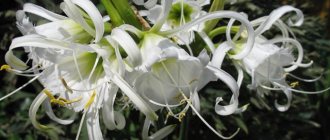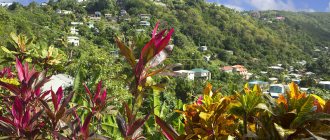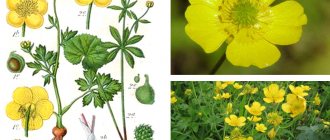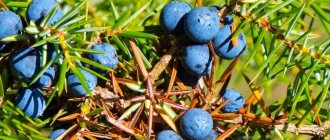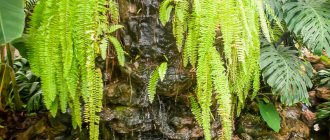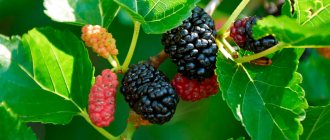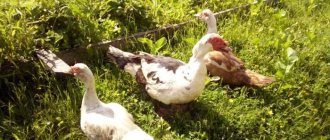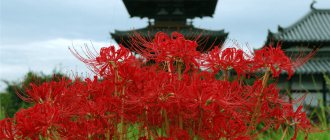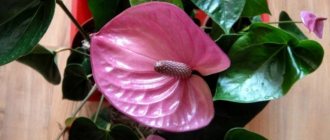Aquilegia is considered one of the most unpretentious plants that is used in folk medicine and in creating landscape designs. Its second name is catchment, and because of the unusual appearance of flowers, aquilegia received the unofficial name “flower of elves.” All the necessary information about such a plant is presented on the Agronom.guru portal.
Catchment (aquilegia)
Botanical description
Aquilegia belongs to the group of perennial herbaceous shrubs. Its root has a branched structure and consists of long, thin shoots. They grow over great distances in depth and width. Because of this feature of the root system, the bush is quite difficult to replant . This especially applies to specimens that have grown in one place for several years.
The length of an adult plant varies from 50 to 80 cm.
At the base of the trunk, leaves are arranged in several levels in the shape of a rosette. Their main growth occurs in the first year after transplantation into open ground.
Some plant species can be 1 m long
The leaves have a fairly long petiole and are cut into two or three equal lobes. Their maximum length does not exceed 5 cm and width 3 cm.
Aquilegia leaves are covered with a thin layer of wax.
Thanks to this feature, rainwater and dew do not wet them, but collect at the edges in the form of large drops. Lanceolate leaves are evenly spaced along the entire length of the stem.
One flower is formed on each shoot. Their maximum number on one stem is 12 pieces.
In the first ten days of July, the buds begin to bloom. The range of shades of the plant's flowers is quite large. The most common colors include:
- blue;
- pink;
- lilac;
- red;
- white.
Each flower stays on the plant for no more than 10 days, after which a new one blooms.
Richness of colors
Bright bloom
Garden decoration
Flower formula
The plant in question belongs to the ranunculaceae family. By analogy with other similar plants, the Aquilegia flower has the following formula *Х5Л5Т5+5+…+5П5.
Interesting information
It is known that this miracle flower has many names due to its appearance, such as eagle, bell, spur, doves, boots.
There are many interesting, sometimes even mystical facts associated with the catchment plant:
It is a symbol of the Holy Spirit in the Christian religion, and holy gifts are associated with its petals.
- Among the northern peoples it is called the “flower of the elves.”
- In the Middle Ages, it was used as a talisman that could protect a person from the effects of magical powers.
- Americans call this flower the Columbine dove, which personifies the fickleness of women (however, the columbine flower symbolizes betrayal and temptation in most nations).
- The French, oddly enough, call it the flower of a grumpy woman: according to ancient belief, if a woman took a decoction of this plant into her mouth, then quarrels and scandals in the house would stop.
- Norwegians symbolize the flowers of the catchment with the goddess of beauty and love - Freya.
- Due to the similarity of the spur of a flower with a jester's cap, it has become a symbol of stupidity among many peoples.
- It is noteworthy that this plant is the symbol of the state of Colorado in the USA.
The aquilegia flower grows in all countries of the Northern Hemisphere of the planet.
Chemical composition
Flowers, trunk, roots and other components of the catchment have not undergone formal chemical testing. To date, the chemical composition is practically unknown.
It has been established that the plant contains two types of alkaloids: berberine and magnoflorine.
The seeds are rich in oils, fat content reaching 15%. It has been established that the raw materials contain the following elements:
- Ascorbic acid.
- Cyanogenic glycoside.
- Flavonoids.
The composition of the catchment has been little studied
Classification
Existing types of aqualegia are divided into three main categories:
- European. A special feature is the spur in the form of a ring or hook.
- American. All varieties of this group have a straight spur.
- Japanese. There is no spur on the bushes of this group.
In total, about 100 species of the plant in question are known and can be found in nature.
There are more than 100 varieties of aquilegia
Pharmacological properties
Due to its chemical composition, the watershed has the following effects on the human body:
- soothing;
- diuretic;
- diaphoretic;
- healing;
- antiseptic;
- pain reliever;
- choleretic;
- laxative.
The calming effect of the catchment provides peace of mind
Indications for use
There are a number of diseases for which the watershed can provide effective assistance:
- impaired kidney function, including the formation of stones;
- mild form of stomach ulcer;
- polyps formed on the mucous membrane;
- accumulation of bile;
- open bleeding of internal organs;
- non-infectious jaundice;
- disruption of the male reproductive system;
- inflammation of the throat and mouth;
- malignant and benign formations of the mammary glands;
- cellulite.
Water catchment is not only a beautiful, but also a useful plant
Contraindications for use
The use of the plant may cause negative effects, so be sure to consult a doctor who specializes in the treatment of the diagnosed disease.
For the following categories of persons, Aquilegia is strictly prohibited in any form:
- women at any stage of pregnancy;
- persons who, due to the characteristics of the body, negatively perceive the effect of the plant;
- women breastfeeding;
- persons under the age of 12 years.
Children under 12 years of age are strictly prohibited from using the plant.
Features of aquilegia
The plant in question develops according to a certain cycle.
In the first season, a renewal area is formed.
It is located at the very base of the stem and the maturation of a new basal rosette occurs in it. In spring, the leaves of the rosette formed in autumn die and a new peduncle is formed.
Depending on the variety of aquilegia, flowers can have different color shades and sizes, and some types of aquilegia are multicolored. Among all species, the majority have a specific outgrowth called a spur. The resulting nectar accumulates in it.
The main feature of all types of catchment is the toxicity of ripened seeds. Their germination time is 1 year after collection.
Columbine seeds are very poisonous
Aquilegia alpine
Its height can vary widely from 25 to 60 cm. The flowers are always large, up to 8 cm, with a variety of shades of blue and purple.
Beautiful openwork leaves with a blue-green tint give the bush an attractive appearance.
The bush actively develops from June to July.
Aquilegia fanata
It is considered one of the most popular ornamental shrubs. Its height varies from 15 to 50 cm.
The flowers located on the trunk actively bloom from June to September.
Aquilegia fan-shaped has several varieties:
- The maximum length of this species does not exceed 15 cm, so it is classified as undersized. Small dimensions and large flowers of various shades have made the Cameo variety in demand among professional landscape designers.
- This series of shrubs is distinguished by beautiful curved spurs and large two-color flowers.
- Flowers on plants of this species are always present in large quantities with bright iridescent shades.
Aquilegia alpine
Aquilegia fanata
Aquilegia vulgaris
Attracts attention with bell-shaped flowers. They can be of several shades: blue, purple, white.
Each flower is located on fairly long petioles with triple leaves of a dark blue hue, which originate at the very root.
Under normal conditions, this variety reaches a size of no more than 60 cm.
Aquilegia hybrid
The plant forms included in this species were obtained by crossing several species of the catchment.
Mostly representatives of the American and ordinary categories of this shrub were used.
Its minimum height is 50 cm, and its maximum is 100 cm. The size of the flowers is 9 cm, and the structure is terry or regular.
Common catchment
Hybrid catchment
Aquilegia goldenflower
This catchment variety is native to North America. The flowers are quite large and do not droop, unlike some other species.
The golden color of the flowers and the presence of a long spur are the distinctive features of this variety.
It tolerates drought and severe frosts well, but is not very popular in regions located in mid-latitudes.
Aquilegia canadensis
The name of the variety was given according to its place of growth. The bush has completely straight spurs and yellowish-red flowers. Optimal conditions for the plant are a large amount of moisture and the absence of direct sunlight.
Aquilegia goldenflower
Aquilegia canadensis
Aquilegia dark
The size of the bush of this variety belonging to the European group varies in a wide range of 30-80 cm. The flowers are drooping with a dark purple tint, and the leaves are bluish in color.
The size of each flower can reach 4 cm, and the small spur has a curved shape with strongly protruding stamens.
This variety blooms starting from the first ten days of June. For him, the best condition for growth is partial shade.
Aquilegia olympic
The maximum height of this variety is no more than 60 cm, but at the same time it has one of the largest flowers of a bluish tint and quite long spurs. Active flowering of the bush begins in mid-May and lasts until the end of June.
Skinner's Aquilegia
This variety tolerates low temperatures best of all.
The plant continues to function when the ambient air drops to -12.
The spurs are almost completely straight, and the variety blooms with a yellow-red tint.
Aquilegia dark
Aquilegia olympic
Skinner's Aquilegia
Spreading
The growing area of the catchment area is quite large. Most often it is found in the southern regions of Siberia, the Trans-Baikal Territory, the Far East, as well as the Crimea and the Caucasus. Grows well in shady forest glades, mountain forests and slopes.
Types and varieties of Aquilegia
About 100 species of the heroine of the article grow under natural conditions. Cultivated varieties of Aquilegia were bred in 35 of them. Plants are conventionally divided into American, European and Japanese.
The latter lack spurs. European flowers have them, they are distinguished by a hook-shaped edge. Aquilegia seedlings are distinguished by long but straight spurs.
Whatever territorial category Aquilegia belongs to, hybrid varieties are popular. They are obtained by crossing different species, taking the best from both.
On packages of seeds, Aquilegia hybrida is designated by the letter F. It must be accompanied by the number “1”. This means that the seeds were taken from a first generation hybrid.
In subsequent generations, varietal properties are lost. This is a minus of hybrid seeds, because terry Aquilegia may lose its velvety fluff, and multi-colored buds may become monochromatic.
But the variety “Mr. Scott Elliott,” for example, has buds with a diameter of 10 centimeters.
Aquilegia Mr. Scott Elliott
Hybrid Aquilegia "Winky" pleases with flowers of an original shape. They resemble roses.
Aquilegia Double Winky red and white
Aquilegia "Barlow" terry. The variety also differs in the almost black color of its petals. The full name of the plant, by the way, is Aquilegia “Nora Barlow”.
Hybrid varieties of grass, as we understand, do not make sense to propagate by seeds. In ordinary varieties of Aquilegia, they can be collected and grown. The seeds of Foxtrot will produce equally tall shoots. They will grow up to 75 centimeters and produce double buds.
The younger generation of the Tower variety will also be tall. It stands out with indigo colored buds. The flowers of "Tower" reach 5 centimeters in diameter. You can prefer conventional varieties to hybrids for several reasons. In addition to the decorative qualities of plants obtained from crossing different species, the requirements are captivating.
Hybrids are unpretentious in care, resistant to diseases and temperature changes. Aquilegia "Ordinary" , for example, survives -35 degrees. Accordingly, the perennial flower successfully winters even in Siberia. Some varieties require covering with straw and film during frosts. However, we’ll talk about caring for the heroine of the article separately.
Application in medicine
Due to the lack of reliable data on the chemical composition of aquilegia, it is used exclusively in traditional medicine. The medicinal properties of the watershed are not officially recognized by the Russian healthcare system. It is used to treat various ailments in Eastern, Tibetan and Mongolian medicine.
Water collection is used only in alternative medicine
Common catchment
This beautiful but poisonous plant is popular among many gardeners and is widely used in landscape design.
“Believe me, people love watersheds for a reason:
The dewdrops have fallen asleep in them, the dawn is quietly dozing.
In the morning he opened his petals today
And bumblebees and moths flew to him..."
Description
Common columbine (Aquilegia vulgaris L.) belongs to the Buttercup family (Ranunculaceae), species of the genus – Columbine. The plant has another common name - Aquilegia vulgaris.
This is a very beautiful perennial herbaceous plant that has an erect, branched, bare stem covered with leaves. The stem of the common columbine is softly pubescent and can reach a height of 30-60 centimeters. The leaves of Aquilegia are basal and long-petiolate. Two or three-lobed leaves are attached at the bottom of the stem, and three-lobed leaves in the upper and middle parts of the stem. Flowers drooping, apical. They have a very wide range of colors - all shades of pink, blue and purple are found, and in the middle there is often white or yellow. The flower size is quite large. The plant has five petals, which are curved and have peculiar spurs at the tips. And the five bent, falling sepals are like petals and have an ovoid, oblong shape. The flower contains many stamens and five pistils. The shape of the flower is such that dew and raindrops can collect in the corolla. Hence the name of the flower - columbine. The fruit of the aquilegia is very dry and can crack. Common columbine blooms at the very beginning of summer, but there are specimens that can bloom in July and August. The plant reproduces by seeds, which fall into the ground in the fall. With artificial propagation, planting can be done in early spring. Reproduction is possible by carefully dividing the bush.
This plant prefers shady forest areas in southern Europe and Scandinavia. It was introduced to North America. The common watershed feels quite comfortable on the fertile lands of the European part of Russia and Ukraine. The plant can grow in parks and meadows on sandy soil.
Article on the topic: Common warthog - useful properties, description
Mentions of the watershed are found among various peoples of the world. There are stories and legends about him. In England it has the name columbine, which in turn is rooted in the Latin columba, which means “dove”. Aquilegia received this name due to the similarity of its flowers to a flying dove. The Greeks believed that the goddess of the dawn, Eros, poured “heavenly moisture” onto the earth from heaven, and the aquilegia collected this dew in her corollas. The Scandinavians were sure that this beautiful flower was protected by little elves, so they called it the flower of the goddess Freya. It was believed that the flower was capable of burning all kinds of evil in the human body, possessing magical fire.
For medicinal purposes, the above-ground, fresh flowering or dried part of the plant, as well as the juice, is used.
Chemical composition
Common watershed contains the alkaloid aquileginin (0.05%), vitamin C, and cyanogenic glycoside compounds. Alkaloids are found in the aerial parts of the plant and flowers; belladonna leaves contain the vitamin. The seeds are rich in fatty oils and contain the alkaloid aquiledine.
The healing properties of the catchment
Water collection is recommended for use as a sedative and analgesic during painful menstruation in women. It is an excellent diuretic and laxative. It is used for stomach colic, mastopathy, mastitis and as an alternative treatment for cellulite. For skin rashes, boils and fistulas in the oral cavity, an external hot infusion helps well. It is prepared from crushed plants, pouring a tablespoon with two glasses of water. You should take 2 tablespoons of this infusion per day. The oral cavity is rinsed several times a day. They also use freshly squeezed columbine juice, 15 drops no more than twice a day. The grass is harvested during the flowering period by cutting off the above-ground part of the plant at a height of ten centimeters. Store in a ventilated, dry place.
Contraindications
Common columbine is an extremely poisonous plant, so it must be used very carefully and under medical supervision.
Use in landscape design
Designers actively use various types of watershed as the main or additional element of the composition. The main component is flowers, which add a bright accent to the landscape of any style.
Various shrubs, flower arrangements, and grass are used in conjunction with the watershed.
For those who are interested in actually completed compositions, in which a watershed was taken as a basis, photos of landscape designs can be found on specialized Internet resources.
Catchment in a flowerbed
In other areas
The catchment plant is actively used by professional florists when creating dry bouquets. Due to their specific appearance, they are used to create group plantings of small trees, shrubs, and lawns.
For what diseases is aquilegia used?
Traditional healers prescribe aquilegia for stomach colic, prolonged cough, pneumonia, cardiovascular diseases, gastroenteritis, sore throat, and headaches. It is very effective for catarrhal jaundice, skin diseases, and nervous attacks. Powder from grass and seeds is used to treat burns and wounds; it is used for scurvy, diseases of the biliary tract, and impotence.
In Mongolia, an infusion of columbine flowers is recommended for general weakness of the body, digestive disorders, and diarrhea. In Tajikistan they drink decoctions for jaundice. The pulp from the fresh plant is effective against scrofula. In Bulgaria, aquilegia juice and the dried aerial part are used for inflammation and skin rashes.
Growing aquilegia from seeds
The optimal period for planting seeds in the ground is the moment of their direct collection. After the first shoots appear in the spring, it is recommended to immediately transplant them to an area of permanent growth.
If you plan to plant seeds in the spring, then the optimal storage conditions are a dry, cool place. To preserve the properties of the seeds, it is recommended to bury them in the ground or place them in the main compartment of the refrigerator.
At the beginning of March, the seeds are planted in the prepared mixture. Its main components:
- river sand;
- formed humus;
- Earth.
All of the above elements are mixed in equal proportions. Before planting the seed in the resulting substrate, it is recommended to water it abundantly.
The container with seeds is placed in a dark place with a temperature of no more than 18 degrees.
Periodically moisten the substrate using a sprayer. After the formation of the first pair of leaves on the stem, the sprout is transplanted into loamy soil.
Catchment sprouts from seeds
What time to plant
It is recommended to plant the resulting seedlings in early June. It is recommended to choose a location that is not exposed to direct sunlight.
You can transplant the plant to a permanent place of growth at the end of August or in the spring of next year.
Aquilegia is a shade-loving plant, so bushes growing in such conditions produce larger flowers for a longer period.
How to plant
The optimal soil must meet the following requirements:
- ease;
- looseness;
- constant humidity.
The digging depth should not exceed 20 cm. The planting density of bushes is 10-12 pieces per square meter. The distance between tall varieties should be at least 40 cm, for low-growing varieties 25 cm.
Aquilegia bush ready for transplanting
How to care for aquilegia
The basic requirements for the full development of the bush are as follows:
- sufficient amount of water;
- complete feeding;
- periodic loosening of the soil;
- timely removal of weeds.
The worst enemy of shrubs is drought. For young plants, it is important to have no weeds that interfere with their full development.
After completing the watering process, the soil must be thoroughly loosened to slow down the process of moisture evaporation.
For the growth and development of the watershed, adequate fertilizing is required. In summer, useful elements are added to the soil at least twice.
The catchment does not like drought
Aquilegia propagation
The plant can propagate in three ways:
- seeds;
- cuttings;
- dividing the bush.
The third method of division is used only in cases of extreme necessity. Transplanting a mature bush is long and painful for it.
The optimal time for dividing it is the beginning of spring or autumn.
It is better to subject a plant that is more than three years old to a similar procedure. When digging it up, special attention must be paid to the safety of the small shoots of the roots.
catchment seedlings
Next, perform the following steps:
- Washing the roots.
- Removing leaves.
- Trimming the stem to a height of 5-7 cm,
- The main root is cut lengthwise to create two equal parts.
- Charcoal is applied to the cut site.
- Planting in separate containers filled with a mixture of nutrients.
Even if all replanting rules are followed, the plant may be sick for a long time.
The propagation process using cuttings is much simpler and faster. In early spring, before the first leaves appear, a young stem is cut off and planted in a greenhouse or open ground.
A shady area with loose soil or river sand is suitable for the landing site. It takes 30 days to form a stable root system, after which the bush is transplanted to a permanent location.
The watershed requires special transplantation rules
Planting and caring for the watershed on the site
Let's share our tips on how to care for Aquilegia in the garden.
Growing Vodosbora seedlings and planting in the garden
Growing Aquilegia flowers from seed is not difficult, but keep in mind that they usually do not bloom until the second year. Additionally, the seeds need a three to four week cooling period before they germinate. You can store seed packets in the refrigerator before sowing.
Catchment Seeds
Plant Columbine seeds in moist soil in a warm, lighted room. The seeds will germinate in about 30 days. Once the seedlings develop a pair of true leaves and reach 7–10 cm in height, transplant them into a flower bed.
Before planting in the garden, Aquilegia seedlings must be “hardened off”. Accustom young plants to open ground conditions by moving them to a protected place outside for a week. Be sure to protect them from wind and hot sun first. For overnight frosts, cover or move containers indoors and then take them out again in the morning. This hardening process strengthens the plant's cellular structure and reduces transplant shock and burns.
The soil
Aquilegia is a plant that does not require good soil, but still grows best in loose, light, moist humus soils. To improve the soil composition, before planting, dig up the watershed and add humus or compost.
Watering
Thorough watering is important for perennial plants to get off to a good start. Water well at least once a week to help the Watershed grow new roots faster. The soil should be moist about 3cm below the soil surface. You can check this by sticking your finger into the ground. Water early in the morning so all the leaves have time to dry.
Catchment variety Aquilegia 'Blue Butterflies'
Until the plants are established, some protection from strong winds and direct, hot sunlight may be needed. Good air movement is also important.
Fertilizers
After the growth of the catchment appears, light fertilizers can be applied. Use low doses of slow-release fertilizer, as higher doses may promote root rot.
Weed control
Regularly inspect your flower beds for weeds during the growing season. Remove weeds; they compete with ornamental plants for water, space and nutrients.
Mulching
Mulch helps retain soil moisture and maintain an even soil temperature. For perennials, organic mulch made from aged bark or shredded leaves gives the bed a natural look and improves the soil as it breaks down over time.
Diseases and pests
There are a number of diseases that aquilegia are most often susceptible to. All flowers on the surface of which signs of the disease are visible are removed from the stem and burned.
There are no effective means and methods to combat gray mold.
To remove rust from a bush, it is recommended to treat it with a special product. The most effective will be a drug that contains sulfur. A solution of soap and copper sulfate has a similar effect.
Rust on columbine leaves
When a watershed becomes infected with powdery mildew, a white coating of fungus appears on it. A few days after infection, the leaves begin to curl, turn brown and die completely. An effective remedy for combating powdery mildew is a solution of colloidal sulfur and soap.
Significant harm to aquilegia can be caused by mites, aphids, nematodes,
To combat mites and aphids, a paste is used, the main component of which is yarrow. An effective drug to get rid of nematodes has not yet been created. The bushes on which these pests are found are removed from the site, and cereals, onions or garlic are planted in their place.
Root nematodes
Brief description of the common catchment
Common columbine (aquilegia) is a perennial herbaceous plant 30–60 cm high. The rhizome is short, the roots are thick. The stem is erect, branched, glabrous or softly pubescent, covered with leaves. The lower leaves are petiolate, doubly trifoliate, with rounded lobed leaves, the stem leaves are doubly trifoliate and trifoliate. The flowers are large, irregular, with spurs, bluish-violet, pink, creamy-white, apical, drooping. The calyx is five-leaved, colored. Corolla with five petals turning into a spur. There are many stamens, several pistils. The fruit is a leaflet, dry, cracking.
Blooms in May – June.
Aquilegia after flowering
After the end of flowering time, it is necessary to remove those stems that have exhausted their resource. Parts of the bush that have not been subject to diseases and insect attacks are a good component of compost, and all the rest must be destroyed.
Seeds are obtained from the best peduncles after they have fully ripened.
To preserve the seeds in full, it is recommended to place the peduncle in a special bag made of gauze. After the flowering process is completed, the bush is ready for division and planting.
Aquilegia peduncle
